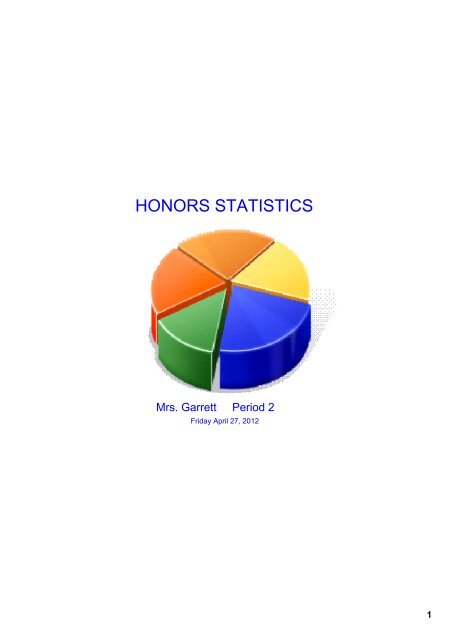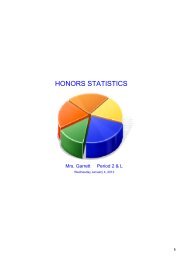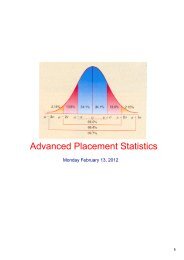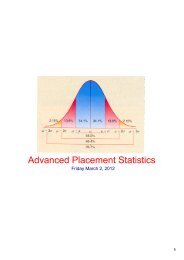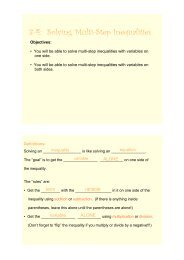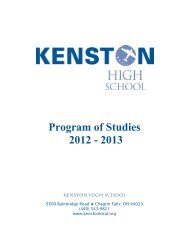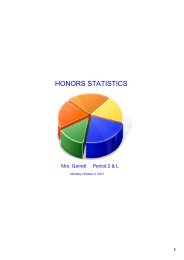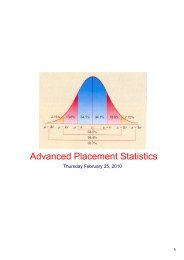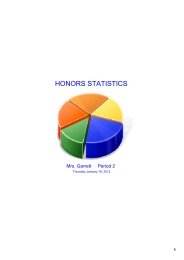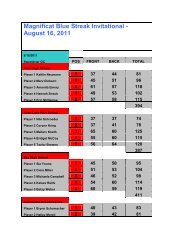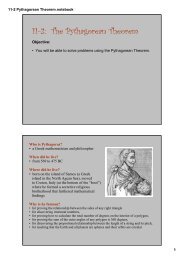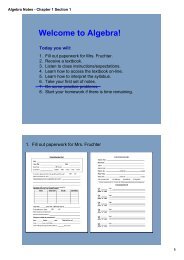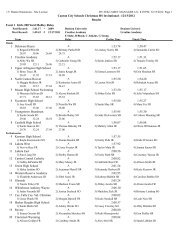April 27 - Kenston School District
April 27 - Kenston School District
April 27 - Kenston School District
Create successful ePaper yourself
Turn your PDF publications into a flip-book with our unique Google optimized e-Paper software.
HONORS STATISTICS<br />
Mrs. Garrett Period 2<br />
Friday <strong>April</strong> <strong>27</strong>, 2012<br />
1
Daily Agenda<br />
1. Welcome to class<br />
2. Please find folder and take<br />
your seat.<br />
3. Review simulations<br />
4. Review homework OTL C6#3<br />
5. Finish Notes and practice on 6.2<br />
6. Collect folders<br />
2
PRACTICE SIMULATION 2<br />
At a local high school, 95 students have permission to park on campus. Each month the student council holds a<br />
“golden ticket parking lottery” at a school assembly. The two lucky winners are given reserved parking spots next to<br />
the school’s main entrance. Last month, the winning tickets were drawn by a student council member from the<br />
Honors Statistics class. When both golden tickets went to members of that same class, some people thought the<br />
lottery had been rigged. There are 28 students in the Honors Statistics class, all of whom are eligible to park on<br />
campus. Design and carry out a simulation to decide whether it’s plausible that the lottery was carried out fairly.<br />
Follow the 5 steps:<br />
3
STEP 1: State the problem<br />
Simulate a golden ticket lottery where there are 95<br />
eligible students and only 2 tickets are winner.<br />
Determine the probability that the two winners are from<br />
the same math class of 28 students.<br />
STEP 2: State assumptions<br />
Assume that the tickets are drawn independently.<br />
All tickets are separated and well mixed.<br />
4
STEP 3: Assign digits<br />
LABEL: use two digit numbers between 01 and 95<br />
Let 01 to 28 represent the students<br />
in the honors statistics class.<br />
Let 29 to 95 represent the other eligible students.<br />
TABLE: use line 139 and pick off 2 digits at a time<br />
STOPPING<br />
PROCEDURE: select 2 digit numbers,<br />
choose 2 different (2 digit) numbers between 01 and 95<br />
for each simulated drawing<br />
Do 20 simulations of the golden ticket lottery<br />
5
STEP 4: Repeat many repetitions ﴾20 simulations of drawing for the golden tickets﴿<br />
IDENTIFY SAMPLE:<br />
Line 139 55588 99404 70708 41098 43563 56934 48394 51719<br />
Line 140 12975 13258 13048 45144 72321 81940 00360 02428<br />
Line 141 96767 35964 23822 96012 94591 65194 50842 53372<br />
DRAW 1 DRAW 2 DRAW 3 DRAW 4<br />
DRAW 5 DRAW 6 DRAW 7 DRAW 8<br />
DRAW 9 DRAW 10 DRAW 11 DRAW 12<br />
DRAW 13 DRAW 14 DRAW 15 DRAW 16<br />
DRAW 17 DRAW 18 DRAW 19 DRAW 20<br />
6
STEP 5: State your conclusion<br />
7
OTL C6 #3 page 416 and 424<br />
pg 416: 6.30, 6.32 part c only, 6.36<br />
pg 424: 6.39, 6.40, 6.41, 6.44<br />
ASkips are 6.30 and 6.39<br />
USE PROPER NOTATION !!!!<br />
P(??) = .??<br />
8
OTL ANSWERS C6#3<br />
pg 416: 6.30, 6.32, 6.36<br />
pg 424: 6.39, 6.40, 6.41, 6.44<br />
6.30 a) S={0 < x < 24, where x = hours}<br />
b) S={0 < x < 11,000 where x = number of physicians}<br />
c) S={0, 1, 2, 3, 4, ..., 12} where x = number of broken eggs<br />
d) S={0 < x < 200.00, where x = dollars}<br />
e) S={100 < x < 200 , where x = grams of weight gain}<br />
6.32<br />
Toss two coins n = 2 2 = 4 S = { HH, HT, TH, TT }<br />
Toss three coins n = 2 3 = 8 S = {HHH THH<br />
HHT THT<br />
HTH TTH<br />
Part c)<br />
HTT TTT<br />
Toss five coins n = 2 5 = 32<br />
{HHHHH THHHH<br />
HHHHT THHHT<br />
HHHTH THHTH<br />
HHHTT THHTT<br />
HHTHH THTHH<br />
HHTHT THTHT<br />
HHTTH THTTH<br />
HHTTT THTTT<br />
HTHHH TTHHH<br />
HTHHT TTHHT<br />
HTHTH TTHTH<br />
HTHTT TTHTT<br />
HTTHH TTTHH<br />
HTTHT TTTHT<br />
HTTTH TTTTH<br />
HTTTT TTTTT}<br />
9
Card Facts:<br />
Use this information for problem 6.36<br />
There are 52 cards in a deck.<br />
There are two colors in a deck.<br />
red and black<br />
There are four suits in a deck.<br />
Hearts, Diamonds,<br />
Spades, and Clubs.<br />
There are 3 different face cards.<br />
King, Queen, Jack<br />
(12 total face cards)<br />
Numbered cards are 2 thru 10<br />
6.36<br />
a) P(red) = 26/52 = .5<br />
b) P(heart) = 13/52 = .25<br />
c) P(queen and heart) = 1/52 = .019<br />
d) P(queen or heart) = 4/52 + 13/52 1/52 = 16/52 = .308<br />
e) P(queen that is not a heart) = 3/52 = .058<br />
There are four Aces "A" in a deck.<br />
10
C6#3 homework continued<br />
6.39 P(CV disease OR cancer) = .45 + .22 = .67<br />
P(other reason) = 1.67 = .33<br />
6.40<br />
a) P(husband does less that his share) = 1 (.12+.61) = 1 .73 = .<strong>27</strong><br />
b) P(husband does at least his share) = .12 + .61 = .73<br />
6.41<br />
a) sum = .41+.23+.29+.06+.01= 1<br />
the probability of all possible outcomes in a sample space = 1<br />
b) P(not in top 20% of high school class) = 1.41 = .59<br />
c) P(student in the top 40%) = .41 + .23 = .64<br />
11
6.44 Benford's Law<br />
The first digits of numbers in legitimate records often follow a<br />
distribution known as Benford's Law.<br />
Here is the distribution.<br />
P(A) = P(first digit is 1) = .301<br />
P(B) = P(first digit is 6 or greater) = .067+.058+.051+.046 = .222<br />
P(C) = P(first digit is odd) = .301+.125+.079+.058+.046 = .609<br />
a) P(D) = P(first digit is less than 4) = .301+.176+.125 = .602<br />
b) P(B U D) = .222 + .602 = .824<br />
c) P(D c ) = 1P(D) = 1.602 = .398<br />
d) P(C ∩ D) = .301 + .125 = .426<br />
e) P(B ∩ C) = .058+.046 = .104<br />
12
Common probability symbolism<br />
U = union of events = or<br />
= intersection of events = and<br />
13
Mutually Exclusive or Disjoint Events<br />
14
Complementary Events<br />
15
INDEPENDENCE IS NOT DISJOINT<br />
DISJOINT SETS<br />
could be Independent<br />
IF two sets are independent their "picture" is intersecting.<br />
IF a picture of two sets is intersecting the two sets may or<br />
may not be independent.<br />
If two sets are independent (set A and set B) then...<br />
Knowing something about set A does nothing to help me decide if the "item" is in set B<br />
Potential independent situation ....<br />
GIRLS<br />
BOYS<br />
Male<br />
Staff member<br />
18
IF two sets are independent this<br />
equation must be TRUE<br />
P(A ∩ B) = P(A)P(B)<br />
.3<br />
.4 .2 .1<br />
does .2 = .6 x .3<br />
.2 = .18<br />
NO<br />
can you change the probabilities<br />
and make the sets independent?<br />
so sets are not independent<br />
Let's try again ...<br />
.1<br />
.5 .3 .1<br />
19
classwork pg 430: 6.46, 6.47, 6.48<br />
6.46 Defective Chips<br />
P(all 12 chips work properly) = 1P(not work) = (1.05) = .95<br />
(but 12 in a row) soooo .95 12 = .54<br />
6.47 One cannot conclude that (.26)(.16) = .0416 because the<br />
events are not known to be INDEPENDENT<br />
(one would think college graduates are less likely to be<br />
machine operators or laborers)<br />
20
6.48 A = person chosen is male<br />
B = person chosen is 25 years old or older<br />
a) Explain why P(A) = .44 7317/16639 = .4397<br />
b) Find P(B) = (3494+2630)/16639 = 0.36805<br />
c) Find P(male and at least 25 years old) = P(A ∩ B)<br />
using the table P(A ∩ B) = (1598+970)/16639<br />
= 2568/16639 = 0.1543<br />
Are A and B independent events ?<br />
Does P(A)xP(B) = P(A ∩ B) ?<br />
0.44 x 0.368 = 0.1543 NO<br />
0.16192 does not equal 0.1543<br />
21
C6 #4 due<br />
Monday 4/30<br />
pg 430: 6.45, 6.49, 6.50, 6.51<br />
Read and notes pg 435 452<br />
A SKIP 6.45<br />
22
class practice exercises<br />
Pg 432: 6.56, 6.57, 6.58, 6.63, 6.64<br />
6.56 Show that non-empty independent events must intersect.<br />
a) if A=non empty and B= non empty<br />
then independent means that P(A)xP(B)= P(A∩B) > 0<br />
b) if A∩B is empty, then P(A∩B)=0, which contradicts<br />
independence<br />
c) Find an example of two events that are neither disjoint or<br />
independent.<br />
6.57 New Census categories<br />
a) verify the table is legit<br />
b) P(A) = (.000+.003+.060+.062)=.125<br />
c) B c = person chosen is NOT white<br />
P(B c ) = (.000+.003+.062+.036+.121+.0<strong>27</strong>) =.249<br />
or P(B) = .060+.691=.751<br />
so P(B c ) = 1-.751 = .249<br />
d) the person chosen is non-Hispanic White = P(A c nB)<br />
P(A c ∩B) = .691 (just pick it off the table)<br />
6.58 Being Hispanic<br />
are the events A and B independent?<br />
Does P(A∩B) = P(A)P(B)?<br />
P(A∩B) = .060 P(A)P(B) = (.125)(.751)=.0939<br />
.060=.0939 SO NOT INDEPENDENT<br />
23


